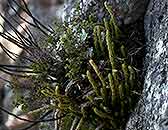Huperzia saururus (Lam.) Trevis.
Synonyms |
Lycopodium saururus Lam. |
|---|---|
Common name |
|
Description |
Horizontal stems compactly branched, with shallow roots; aerial stems erect, unbranched, 9-60 x 2 cm including the leaves. Foliage leaves 8-13 × 2 mm, closely overlapping, lanceolate to narrowly oblong-lanceolate in outline, entire, coriaceous, mid- to light green. Fertile portion not differentiated; sporophylls the same size and shape as the foliage leaves; sporangia yellow-brown, rounded-kidney shaped, 1.5-2 mm, hidden in the leaf axils at the end of the stem. |
Notes | H. saururus is easily recognisable by its unbranched, erect stems that have an indistinct fertile portion; sporophylls similar to foliage leaves. |
Derivation | saururus: lizard-like, referring to the scaly appearance of the stems. |
Habitat | Rock crevices in montane areas, mossy, earth streambanks in montane forest, sphagnum swamps, boggy moorland, Hagenia forest. |
Distribution worldwide | Africa, Comoros, Réunion, Mauritius, Kerguelen Isl., Tristan da Cunha and St. Helena, Madagascar and the Andes in S America. |
Distribution in Africa |
Cameroon, Dem. Republic of Congo, Ethiopia, Kenya, Lesotho, Malawi, Rwanda, South Africa, Tanzania , Uganda, Zimbabwe. |
Growth form |
Lithophytic, terrestrial. |
Literature |
|


